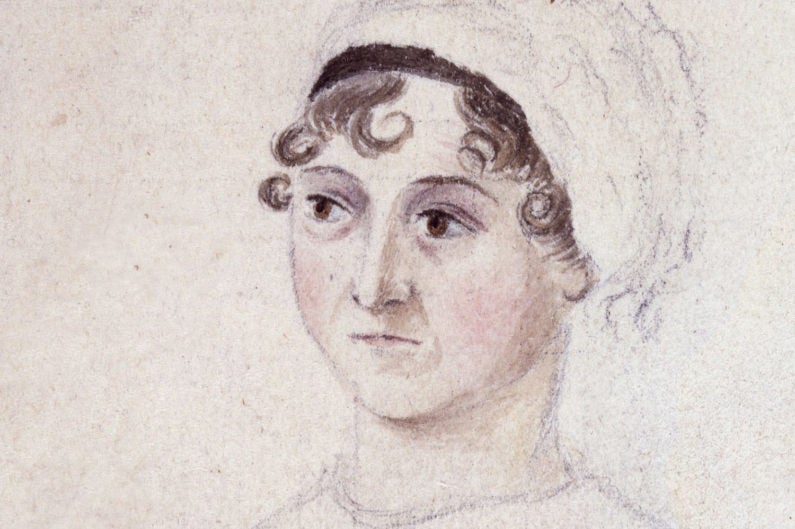Stanford literary scholars reflect on Jane Austen’s legacy
English Professor Alex Woloch and two doctoral students discuss author Jane Austen’s writing style and why her novels still dominate literary and popular culture 200 years after her death.
Two centuries after Jane Austen’s death, the early 19th-century English author’s words persist in our culture.

This drawing of Jane Austen was made by her sister, Cassandra, around 1810. (Image credit: National Portrait Gallery, London)
Austen, who died on July 18, 1817, at 41, is known for her six completed novels, among them the highly adapted Pride and Prejudice and Sense and Sensibility. Originally published anonymously, the works gained recognition among readers and scholars in the 20th century.
Now, most literary academics can’t imagine discussing the modern novel without crediting Austen’s contributions to the art form.
Stanford English Professor Alex Woloch said he doesn’t remember a time when he wasn’t interested in Austen’s work.
An expert on the history and theory of the novel, Woloch said he focused a large part of his doctoral dissertation, which examined the creation of minor and major characters in novels, on Austen. He has subsequently taught and studied her work throughout his career.
“Austen is one of the biggest literary figures in English,” said Woloch, chair of the Department of English. “At this point, she is somewhat like Shakespeare, her centrality is so established.”
Austen’s writing stands out for its comedy, self-awareness and realistic, detailed portrayals of characters and their relationships.
“There is a level of intelligence in her work that the reader feels, and it has to do with her psychological perceptiveness and the sheer skill of her writing,” Woloch said. “When you read Jane Austen, you sense that you’re in the hands of someone authoritative and reliable … But there is always this feeling that she is one step ahead of you.”
Literary scholars, in particular, point to Austen’s subtle, innovative use of free indirect discourse as a style of third-person narrative. This style, in which a character’s perspective and thoughts intertwine with the narrator of the story, is now widespread in modern fiction, but was just taking shape in the late 18th and early 19th century.
“Austen was really ahead of her time,” Woloch said. “She is canonical in a way that she probably would not have anticipated. Her work falls so easily into dialogue not just with past literature but, strangely, with novels that had yet to be written.”
Austen’s style set the stage for the movement of literary realism, which took off in the mid-19th century and included writers such as Leo Tolstoy, George Eliot and Charles Dickens, said Elizabeth Wilder, an English PhD candidate.
“Because Austen’s contributions have been so widely adopted and adapted by other authors, it can be easy to forget how groundbreaking her work really was,” Wilder said.
Austen’s popularity was modest largely because her works were published anonymously. Her current renown can be traced to the 1940s when literary scholars began analyzing her work more closely and feminist critics, in particular, brought her achievements to light.
“Maybe no canonical author seems more accessible than Austen,” English doctoral student Matthew Redmond said. “People speak of loving Shakespeare, but too many don’t feel equal to the task of reading him. Not so with Austen.”
Pride and Prejudice, Austen’s most popular work, exemplifies the qualities of her storytelling.
“Pride and Prejudice has transcended the novel form and become a modern myth,” Redmond said. “Had Austen written only that work, we could still speak of her as having dramatically increased the depth and resolution of English prose.”
But many scholars see Emma, where Austen’s unique narration style reaches full force, as her greatest novel, Woloch said.
“Emma is famous in that you could reread it and it gets more interesting,” said Woloch, who often teaches Emma in his classes. “Not every piece of literature holds up with time. Some things become boring.”
Wilder, whose dissertation includes the study of Austen’s work, said she considers Persuasion to be one of the author’s most important works as well.
The book, which was Austen’s last completed novel, takes place during the Napoleonic Wars and focuses on themes of regret, loss and lives unled, more so than her other works.
“For me, Persuasion is one of Austen’s most interesting and important novels – in part because she breaks a lot of her own rules in it,” Wilder said. “The novel’s setting invites us to think about the relationship of the political to the personal or the domestic. It’s startling to think of Austen as a war novelist, but Persuasion reminds us of just how extensive her vision was.”
